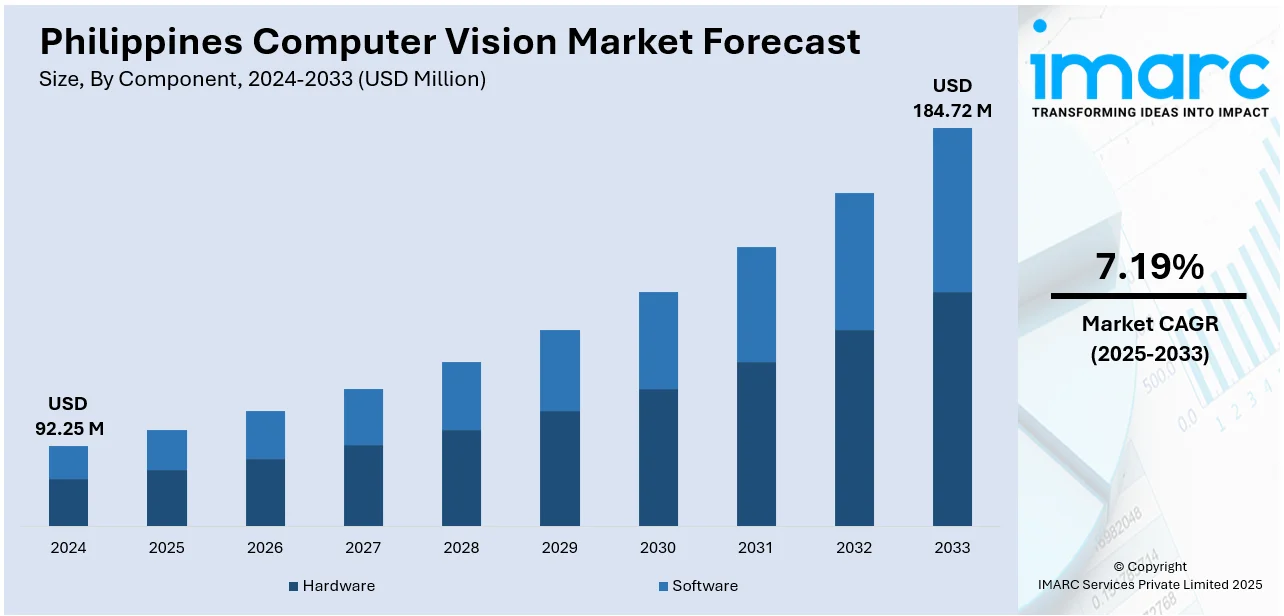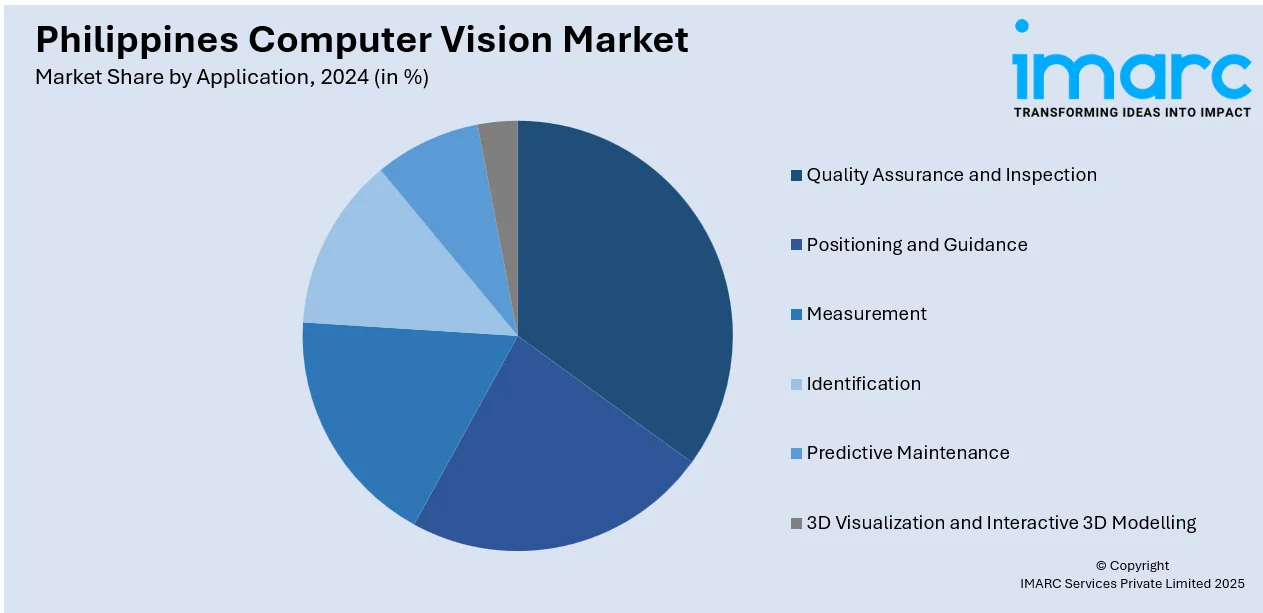
Philippines Computer Vision Market Size, Share, Trends and Forecast by Component, Product Type, Application, Vertical, and Region, 2025-2033
Philippines Computer Vision Market Overview:
The Philippines computer vision market size reached USD 92.25 Million in 2024. The market is projected to reach USD 184.72 Million by 2033, exhibiting a growth rate (CAGR) of 7.19% during 2025-2033. Digital transformation, demand for smart surveillance, and adoption of automated analytics drive the sector. Partnerships with tech providers, AI integration, and regulatory modernization support expansion. Cloud infrastructure and talent development increase Philippines computer vision market share.
|
Report Attribute
|
Key Statistics
|
|---|---|
|
Base Year
|
2024
|
|
Forecast Years
|
2025-2033
|
|
Historical Years
|
2019-2024
|
| Market Size in 2024 | USD 92.25 Million |
| Market Forecast in 2033 | USD 184.72 Million |
| Market Growth Rate 2025-2033 | 7.19% |
Philippines Computer Vision Market Trends:
Public Surveillance and Safety Frameworks
Government-led initiatives to enhance urban security and disaster preparedness propel Philippines computer vision market growth. Smart city projects in Metro Manila integrate AI-powered CCTV and facial recognition for traffic monitoring and crime deterrence. Emergency response systems incorporate crowd behavior analysis and flood detection models. Funding incentives from the Department of Science and Technology support pilot deployments. Local software development companies leverage computer vision for license plate recognition and anomaly alerts. Institutional collaboration with police agencies ensures regulatory compliance and ethical deployment. These smart surveillance applications build stakeholder trust and demonstrate efficacy across civic infrastructure. For instance, in October 2024, Hinduja Global Solutions (HGS) launched an AI Hub in Manila to support public surveillance and smart city initiatives in the Philippines. The facility showcases technologies like computer vision, speech AI, and analytics to develop real-time safety and monitoring solutions. Platforms such as HGS Agent X enable applications in crowd behavior analysis, anomaly detection, and emergency response. This aligns with government efforts to enhance urban safety, positioning HGS as a key contributor to public infrastructure and boosting Philippines computer vision market growth.

To get more information on this market, Request Sample
Growing Adoption of AI-Powered Computer Vision in the Defense Sector
The Philippines is witnessing a rising trend in the adoption of AI-powered computer vision technologies, particularly in defense and security applications. For instance, in August 2025, Safe Pro Group Inc. completed a week-long training with the Philippine military on AI-powered drone operations for detecting landmines and unexploded ordnance. Using its SpotlightAI™ system and SPOTD technology, Safe Pro trained 30+ Explosive Ordnance Disposal technicians at Camp Aquino, Tarlac, enhancing real-time threat detection. This effort supports humanitarian demining in Asia-Pacific, a region heavily affected by landmines and UXOs. Safe Pro’s AI-driven solutions leverage drone imagery and cloud computing to improve safety and efficiency in defense and humanitarian operations globally. Leveraging cloud-based AI platforms, the Philippines is poised to expand its use of computer vision in defense, aligning with regional security priorities and global technological advancements. This trend signals growing market opportunities for AI-driven security solutions in the Philippines.
Philippines Computer Vision Market Segmentation:
IMARC Group provides an analysis of the key trends in each segment of the market, along with forecasts at the country and regional levels for 2025-2033. Our report has categorized the market based on component, product type, application, and vertical.
Component Insights:
- Hardware
- Software
The report has provided a detailed breakup and analysis of the market based on the component. This includes hardware and software.
Product Type Insights:
- Smart Camera-Based
- PC-Based
A detailed breakup and analysis of the market based on the product type have also been provided in the report. This includes smart camera-based and PC-based.
Application Insights:

- Quality Assurance and Inspection
- Positioning and Guidance
- Measurement
- Identification
- Predictive Maintenance
- 3D Visualization and Interactive 3D Modelling
The report has provided a detailed breakup and analysis of the market based on the application. This includes quality assurance and inspection, positioning and guidance, measurement, identification, predictive maintenance, and 3D visualization and interactive 3D modelling.
Vertical Insights:
- Industrial
- Non-Industrial
A detailed breakup and analysis of the market based on the vertical have also been provided in the report. This includes industrial and non-industrial.
Regional Insights:
- Luzon
- Visayas
- Mindanao
The report has also provided a comprehensive analysis of all the major regional markets, which include Luzon, Visayas, and Mindanao.
Competitive Landscape:
The market research report has also provided a comprehensive analysis of the competitive landscape. Competitive analysis such as market structure, key player positioning, top winning strategies, competitive dashboard, and company evaluation quadrant has been covered in the report. Also, detailed profiles of all major companies have been provided.
Philippines Computer Vision Market News:
- In August 2025, Matrice.ai, a company that provides platform for real-time computer vision solutions, expanded its seed funding round. Led by Voltage Park, with participation from Ax3.ai, Plug and Play Ventures, and angel investors, the funding will support scaling infrastructure, real-time AI pipeline deployment.
- In June 2024, Unilever leveraged AI to create ultra-personalised beauty experiences, driving customer engagement and sales. Tools like BeautyHub PRO and Dove’s Scalp + Hair Therapist use computer vision and generative AI to analyse user selfies and concerns, offering customised product recommendations. In the Philippines, BeautyHub PRO has seen strong uptake, boosting purchase rates and data-driven marketing.
Philippines Computer Vision Market Report Coverage:
| Report Features | Details |
|---|---|
| Base Year of the Analysis | 2024 |
| Historical Period | 2019-2024 |
| Forecast Period | 2025-2033 |
| Units | Million USD |
| Scope of the Report |
Exploration of Historical Trends and Market Outlook, Industry Catalysts and Challenges, Segment-Wise Historical and Future Market Assessment:
|
| Components Covered | Hardware, Software |
| Product Types Covered | Smart Camera-Based, PC-Based |
| Applications Covered | Quality Assurance and Inspection, Positioning and Guidance, Measurement, Identification, Predictive Maintenance, 3D Visualization and Interactive 3D Modelling |
| Verticals Covered | Industrial, Non-Industrial |
| Regions Covered | Luzon, Visayas, Mindanao |
| Customization Scope | 10% Free Customization |
| Post-Sale Analyst Support | 10-12 Weeks |
| Delivery Format | PDF and Excel through Email (We can also provide the editable version of the report in PPT/Word format on special request) |
Key Questions Answered in This Report:
- How has the Philippines computer vision market performed so far and how will it perform in the coming years?
- What is the breakup of the Philippines computer vision market on the basis of component?
- What is the breakup of the Philippines computer vision market on the basis of product type?
- What is the breakup of the Philippines computer vision market on the basis of application?
- What is the breakup of the Philippines computer vision market on the basis of vertical?
- What is the breakup of the Philippines computer vision market on the basis of region?
- What are the various stages in the value chain of the Philippines computer vision market?
- What are the key driving factors and challenges in the Philippines computer vision market?
- What is the structure of the Philippines computer vision market and who are the key players?
- What is the degree of competition in the Philippines computer vision market?
Key Benefits for Stakeholders:
- IMARC’s industry report offers a comprehensive quantitative analysis of various market segments, historical and current market trends, market forecasts, and dynamics of the Philippines computer vision market from 2019-2033.
- The research report provides the latest information on the market drivers, challenges, and opportunities in the Philippines computer vision market.
- Porter's five forces analysis assist stakeholders in assessing the impact of new entrants, competitive rivalry, supplier power, buyer power, and the threat of substitution. It helps stakeholders to analyze the level of competition within the Philippines computer vision industry and its attractiveness.
- Competitive landscape allows stakeholders to understand their competitive environment and provides an insight into the current positions of key players in the market.
Need more help?
- Speak to our experienced analysts for insights on the current market scenarios.
- Include additional segments and countries to customize the report as per your requirement.
- Gain an unparalleled competitive advantage in your domain by understanding how to utilize the report and positively impacting your operations and revenue.
- For further assistance, please connect with our analysts.
 Request Customization
Request Customization
 Speak to an Analyst
Speak to an Analyst
 Request Brochure
Request Brochure
 Inquire Before Buying
Inquire Before Buying




.webp)




.webp)












